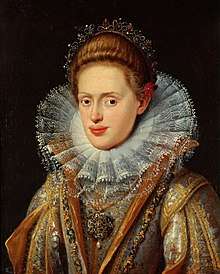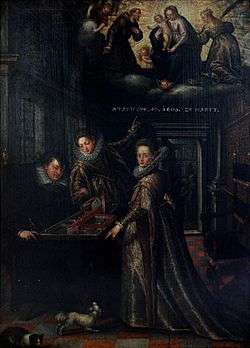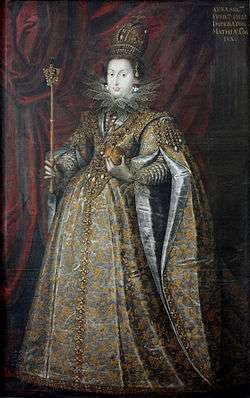Anna of Tyrol
Anna of Tyrol (4 October 1585 – 14 December 1618), was by birth Archduchess of Austria and member of the Tyrolese branch of the House of Habsburg and by marriage Holy Roman Empress, German Queen, Queen of Bohemia and Queen of Hungary.[1]
| Anna of Tyrol | |
|---|---|
 | |
| Holy Roman Empress Queen consort of Germany | |
| Tenure | 21 May 1612 – 14 December 1618 |
| Queen consort of Hungary and Bohemia | |
| Tenure | 4 December 1611 – 14 December 1618 |
| Born | 4 October 1585 Innsbruck, Austria |
| Died | 14 December 1618 (aged 33) Vienna, Austria |
| Burial | Imperial Crypt, Vienna |
| Spouse | |
| House | Habsburg |
| Father | Ferdinand II, Archduke of Austria |
| Mother | Anna Juliana Gonzaga |
| Religion | Roman Catholic |
The first crowned Holy Roman Empress since the mid-15th century, she was responsible for the moving of the Imperial court from Prague to Vienna, which became one of the centers of European culture. A proponent of the Counter-Reformation, she held a great influence over her husband, with whom she founded the Imperial Crypt, which later became the burial place of the Habsburg dynasty.
Life
Early years
Anna was born in Innsbruck on 4 October 1585[2][3] as the third and last daughter of Ferdinand II, Archduke of Further Austria, and Count of Tyrol, and his second wife, Anna Caterina Gonzaga.[4] She had two older sisters, Archduchesses Anna Eleonore (26 June 1583 – 15 January 1584) and Maria (16 June 1584 – 2 March 1649), later a nun. All them suffered from poor health from birth.[5]
Her baptism was conducted with special solemnity, being organized by her uncles Maximilian III, Archduke of Austria, and Prince Ferdinand of Bavaria. The godfather of the princess was Emperor Maximilian II (another uncle), for whom his son Archduke Ernest of Austria stood as proxy, while the rite was celebrated by the Bishop of Brixen.[6]

Anna spent her childhood at the Innsbruck court, which thanks to her parents became in the center of Renaissance culture. She lived in Ambras Castle, Hofburg and Ruelyust Palaces. In order to protect the health of her daughter, since 1590 Archduchess-Countess Anna Caterina had a personal cookbook. In January 1595, the princess lost her father. Her widowed mother made every effort to give her daughters a good education. Anna then discovered an unusual musical talent, which was acquired for her clavichord (a rare and expensive instrument), and a teacher was hired. The love for music remained in the princess throughout her life.[5][7]
Anna was raised in a strict Catholic environment. Even as Holy Roman Empress, when she believed that she had committed a sin, she engaged in self-flagellation to torment the flesh. Anna Caterina made frequent pilgrimages, but didn't take her daughters with her due to their poor health. In 1606, she decided to found a convent there in Innsbruck for the Servants of Mary, Religious Sisters of the Servite Third Order, of which she was a member, and after arranging the marriage of her youngest daughter, she took her monastic vows, taking a new name - Anna Juliana. Maria, Anna's older sister, followed their mother's example and also took the veil in the same convent under their mother's former name.[5]
Marriage and coronation
Upon reaching adulthood, Anna began to receive offers of marriage. The first proposal was made in 1603 by King Sigismund III of Poland (then a widower), but Emperor Rudolf II didn't give his consent. Then the Emperor expressed his intention to marry the princess and sent his court painter to Innsbruck, to make a portrait of his intended bride. Once the Emperor showed his interest in Anna, her mother stopped taking other marriage proposals for her, but soon Rudolf II retracted his proposal. The Emperor's younger brother Archduke Matthias also began to woo her, and some time later, Rudolf II allowed the marriage of his brother to his former fiancée.[5]
Anna and Matthias (at that point already King of Hungary and Bohemia) married on 4 December 1611 in Vienna at the Augustinian Church;[8] bride and groom were first cousins –Matthias' father Emperor Maximilian II was an elder brother of Anna's father, Archduke Ferdinand II. Matthias, although he was already in his fifties, hoped to sire an heir with his 26-year-old wife.[9] Four years later, when Anna became slightly stout, rumors began at the imperial court that she had finally become pregnant. But soon courtiers began to joke that her corpulence was not related to a pregnancy but because she had a very good appetite. Ultimately, the union was childless.[10][11]

On 21 May 1612 Matthias was elected King of Germany and Holy Roman Emperor. Anna was crowned Holy Roman Empress and Queen of Germany in Frankfurt on 15 June 1612, two days after her husband, re-assuming the tradition of the coronation of emperors' wives. She was the first crowned Empress since Eleanor of Portugal.[12] Anna was also crowned Queen of Hungary on 25 March 1613 in Pressburg[13] and Queen of Bohemia on 10 January 1616 in Prague.[2][3]
Called the "Good-natured and loving Empress",[14] she had a great influence over her husband, jointly with Matthias' mistress Susana Wachter.[15] Contemporaries called both spouses the "Working Couple" (de: Arbeitspaar).[16] Upon his wife's request Matthias transferred the Imperial court from Prague to Vienna,[17] and soon, thanks to their joint efforts, the new court was one of the centers of European culture.[18] The Empress was also noted for the special protection she provided to her Tyroleans subjects, arranging different positions for them at court.[19] As a devout Catholic, she refused to talk to or interact with Protestant courtiers.[20] Like her mother, Anna collected relics, especially from the holy ascetics. She also patronized the Capuchins, and later played an important role in the Austrian Counter-Reformation.[21] For her devotion to the Roman Catholic Church, Pope Paul V awarded the Empress with the Golden Rose.[16]
Last years and death
In 1617 Anna and her husband founded the Capuchin Church, Vienna. On 10 November 1618[22] construction began on their tomb. Anna died a month after construction started, on 14 December 1618[2][3][23] aged 33; her husband died only three months later, on 20 March 1619. Both spouses were temporarily buried in the royal Poor Clare monastery in Vienna.[lower-alpha 1][25] Only after the completion of construction of the built, which was continued by their cousin and successor, Emperor Ferdinand II, in 1633 the coffins with the remains of Matthians and Anna were transferred into the tomb, known as the Imperial Crypt. Their coffins were placed side by side.[26] It was only during the reign of Emperor Ferdinand III that the Imperial crypt finally became the burial place of the Habsburg dynasty.[24][27][28]
Ancestors
| Anna of Tyrol | Father: Ferdinand II, Archduke of Austria |
Paternal Grandfather: Ferdinand I, Holy Roman Emperor |
Paternal Great-grandfather: Philip I of Castile |
| Paternal Great-grandmother: Joanna of Castile | |||
| Paternal Grandmother: Anna of Bohemia and Hungary |
Paternal Great-grandfather: Vladislaus II of Bohemia and Hungary | ||
| Paternal Great-grandmother: Anne de Foix | |||
| Mother: Anne Juliana Gonzaga |
Maternal Grandfather: Guglielmo I Gonzaga |
Maternal Great-grandfather: Federico II, Duke of Mantua | |
| Maternal Great-grandmother: Margaret Palaeologina | |||
| Maternal Grandmother: Eleonora of Austria |
Maternal Great-grandfather: Ferdinand I, Holy Roman Emperor | ||
| Maternal Great-grandmother: Anna of Bohemia and Hungary |
Notes
- The monastery, which were first buried the remains of Anna and Matthias, was demolished in 1782. Later on this place, new buildings were built, most of which were Protestant prayer houses.[24]
References
- "Matthias | Holy Roman emperor". Encyclopædia Britannica.
- Wurzbach 1860, p. 152.
- Korotin 2016, p. 125.
- Braun, Keller, Schnettger 2016, pp. 99–100.
- Rotraud Becker: Gonzaga, Anna Caterina, arciduchessa del Tirolo e dell'Austria Anteriore – Dizionario Biografico degli Italiani - Volume 57 (2001) in: www.treccani.it [retrieved 20 November 2016].
- Braun, Keller, Schnettger 2016, p. 100.
- Braun, Keller, Schnettger 2016, pp. 101–102.
- Braun, Keller, Schnettger 2016, p. 105.
- Peter Hamish Wilson: The Thirty Years War: Europe's Tragedy, p. 242, Cambridge, Mass.: Harvard University Press 2009 — 996 p. — ISBN 978-0-67-403634-5.
- Braun, Keller, Schnettger 2016, p. 106.
- L. Duerloo: Dynasty and Piety: Archduke Albert (1598—1621) and Habsburg Political Culture in an Age of Religious Wars, p. 421, London: Routledge 2016 — 610 p. — ISBN 978-1-31-714728-2.
- Barbara Stollberg-Rilinger: The Emperor's Old Clothes: Constitutional History and the Symbolic Language of the Holy Roman Empire, p. 161, vol. X, New York: Berghahn Books 2015 (Publications of the German Studies Association) — 356 p. — ISBN 978-1-78-238805-0.
- Braun, Keller, Schnettger 2016, p. 112.
- "Südtirol in Wort und Bild". Südtirol-Verlag Herbert Neuner. 11 August 2000 – via Google Books.
- P. L. Jacob, Franz Helbing: Geschichte der prostitution, Berlin: J. Gnadenfeld 1908, vol. VI, p. 15.
- Braun, Keller, Schnettger 2016, p. 114.
- Richard Kralik: Geschichte der Stadt Wien: und ihrer Kultur, p. 190, Paderborn: Books on Demand 2015 — 616 p. — ISBN 978-3-84-607622-4.
- Erich Scheinder: Schriften des Vereins für Geschichte des Bodensees und seiner Umgebung, Schriften des Vereins für Geschichte des Bodensees und seiner Umgebung (magazine) 1987, N° 105, p. 71.
- Braun, Keller, Schnettger 2016, pp. 107–108.
- Franz Martin Mayer: Von Jahre 1526 bis zur Gegenwar, Vienna: Braumüller 1901, vol. II, p. 112 — 797 p.
- Alfred Noe: Giambattista Marinos Wort-Zucht-Peitschen und die Gegenreformation in Wien um 1655: Textedition und Kommentar, Vienna: Böhlau ed. 2015, p. 102 — 168 p. — ISBN 978-3-20-579696-1.
- Kapuzinerkirche. Geschichte in: www.klostergeschichten.at Archived 30 September 2016 at the Wayback Machine [retrieved 20 November 2016].
- Anne J. Duggan: Queens and Queenship in Medieval Europe: Proceedings of a Conference Held at King’s College London, April 1995, Woodbridge: Boydell Press 1997 (History of the Valois Burgundy) — p. 104 — 357 p. — ISBN 978-0-85-115881-5.
- Die Kaisergruft bei den P.P. Kapuzinern in Wien: Ein historisch-chronologisches Verzeichniss aller daselbt ruhen den höchsten Personen bis auf die heutige Zeit, Vienna: Anton Schweiger 1859, pp. 3–4. — 31 p.
- Sabine Weiss: Claudia de´ Medici, Innsbruck: Tyrolia ed. 2004 — p. 288 — 304 p. — ISBN 978-3-70-222615-2.
- Gotthard Matysik: List of austrian sovereigns 1141 — 1918. 1608 — 1619: Matthew (Matthias) in: royaltombs.dk [retrieved 20 November 2016].
- Bernhard Kauntz: Die Kapuzinergruft in: werbeka.com [retrieved 20 November 2016].
- Sonja Schmöckel: The Kapuzinergruft – last residence of the Habsburgs in: www.habsburger.net [retrieved 20 November 2016].
Bibliography
| Wikimedia Commons has media related to Anna of Tyrol. |
- Braun, Bettina; Keller, Katrin; Schnettger, Matthias (4 April 2016). Nur die Frau des Kaisers?: Kaiserinnen in der Frühen Neuzeit (in German). Böhlau Verlag Wien. p. 99–116. ISBN 978-3-205-20085-7.CS1 maint: ref=harv (link)
- Korotin, Ilse (2016). Lexikon österreichischer Frauen. Vienna: Böhlau. ISBN 978-3-20-579590-2., pp. 152–4248 p. online
- Wurzbach, C. von (2012) [1860]. "Eleonore Gonzaga". Biographisches Lexikon des Kaisertums Österreich (in German). Austria: Austrian Literature Online, University of Innsbruck. p. 152, 492 p.
Anna of Tyrol Born: 4 October 1585 Died: 14 December 1618 | ||
| German royalty | ||
|---|---|---|
| Preceded by Maria of Spain |
Empress of the Holy Roman Empire German Queen 1612–1618 |
Succeeded by Eleanor of Mantua |
| Queen consort of Hungary 1611–1618 | ||
| Queen consort of Bohemia 1611–1617 |
Succeeded by Elizabeth of England | |